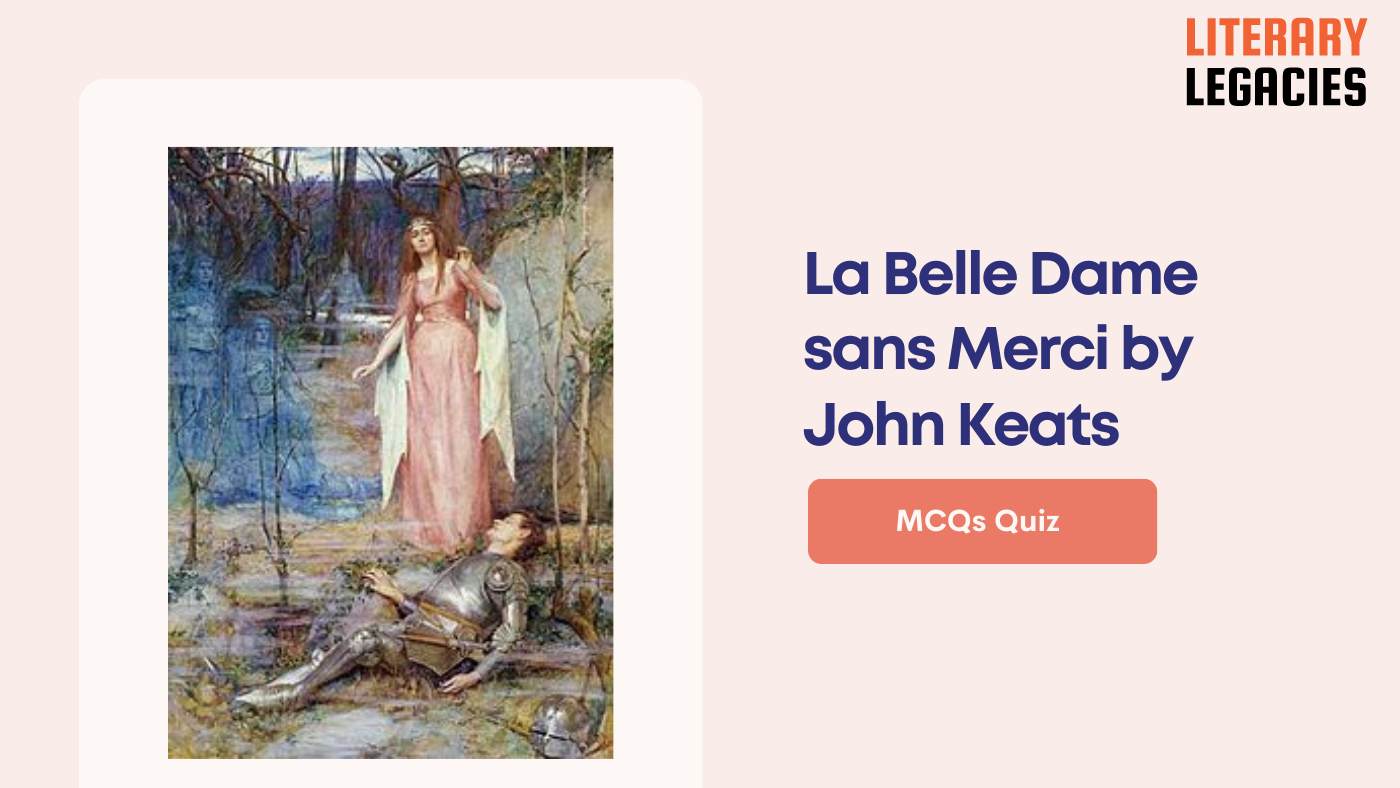1. What is the title of the poem by John Keats being discussed?
A. A Medieval Romance
B. The Beautiful Woman
C. The Knight’s Tale
D. La Belle Dame sans Merci
Answer: La Belle Dame sans Merci (D)
The title of the poem is French and translates to ‘the beautiful lady without mercy’.
2. Where did John Keats get the title of the poem from?
A. A medieval French fairy tale
B. A 15th-century courtly love poem by Alain Chartier
C. A 12th-century medieval legend
D. A Shakespearean sonnet
Answer: A 15th-century courtly love poem by Alain Chartier (B)
The title is inspired by a 15th-century courtly love poem by Alain Chartier.
3. What is the physical appearance of the knight-at-arms in the poem?
A. He is dark-skinned with a scar above his left eyebrow
B. He has a beard and a broken arm
C. He is tall and muscular
D. He has a lily-white forehead and a rose-coloured cheek
Answer: He has a lily-white forehead and a rose-coloured cheek (D)
The knight-at-arms is described as having a lily-white forehead and a rose-coloured cheek.
4. What does the rose symbolize in the poem?
A. The beauty of nature
B. The poem’s medieval setting
C. The knight’s patriotism
D. Love that has gone rotten
Answer: Love that has gone rotten (D)
The withering rose symbolizes love that has gone rotten.
5. Who is the initial speaker in the poem?
A. An unknown narrator
B. The poet himself
C. The knight-at-arms
D. A woodland creature
Answer: An unknown narrator (A)
The initial speaker is an unknown narrator who questions the knight-at-arms.
6. What happens to the voice in the poem after the knight is questioned?
A. It disappears
B. It remains with the narrator
C. It becomes a chorus
D. It shifts to the knight-at-arms
Answer: It shifts to the knight-at-arms (D)
The voice shifts from the narrator to the knight-at-arms after he is questioned.
7. What is the setting of the poem?
A. A hillside
B. A bustling city
C. A dark forest
D. A medieval castle
Answer: A hillside (A)
The poem is set on a hillside where the knight-at-arms is found.
8. What is the poem’s tone?
A. Lighthearted and humorous
B. Sarcastic and ironic
C. Dark and melancholic
D. Adventurous and romantic
Answer: Dark and melancholic (C)
The poem has a dark and melancholic tone due to the knight’s situation.
9. What is the significance of the knight-at-arms’ pale forehead?
A. It indicates good health
B. It suggests the knight is tired
C. It is a sign of his emotional state
D. It symbolizes bravery
Answer: It is a sign of his emotional state (C)
The knight’s pale forehead is a sign of his emotional state, which is melancholic.
10. What is the poem ‘La Belle Dame sans Merci’ often classified as?
A. A Shakespearean sonnet
B. A romantic ballad
C. A medieval epic
D. A courtly love poem
Answer: A courtly love poem (D)
The poem is often classified as a courtly love poem, which is a medieval genre.
11. Why is the poem ‘La Belle Dame sans Merci’ widely anthologized?
A. Because it is one of Keats’s most famous poems
B. Because it is a poem about love
C. Because it is a medieval legend
D. Because it is a rare poem by John Keats
Answer: Because it is one of Keats’s most famous poems (A)
The poem is widely anthologized because it is one of John Keats’s most famous poems.
12. What is the knight’s perception of the lady he meets in the meadows?
A. She is a mortal woman with an ordinary nature.
B. She is a noblewoman with a kind heart.
C. She is a witch trying to cast a spell on him.
D. She is the child of a faery with supernatural qualities.
Answer: She is the child of a faery with supernatural qualities. (D)
The knight’s description of the lady’s wild eyes and supernatural qualities suggests that he believes she is the child of a faery.
13. What is the significance of the gifts the knight gives to the lady?
A. They are magical objects that grant him protection.
B. They are tokens of his admiration and affection for the lady.
C. They are symbols of his wealth and power.
D. They are part of a ritual to summon the faery’s powers.
Answer: They are tokens of his admiration and affection for the lady. (B)
The knight’s gifts of a garland, bracelets, and a sweet-smelling girdle suggest that he is trying to win the lady’s favor and affection.
14. How does the lady respond to the knight’s gifts?
A. She tries to return them to the knight.
B. She looks as though she loves them and moans sweetly.
C. She is indifferent to them and doesn’t react.
D. She rejects them with disdain.
Answer: She looks as though she loves them and moans sweetly. (B)
The lady’s response to the knight’s gifts suggests that she is pleased and delighted by them.
15. What is the significance of the ‘faery’s song’ that the lady sings?
A. It is a magical spell to enthrall the knight.
B. It is a way to communicate with the faery kingdom.
C. It is a way to express her joy and happiness.
D. It is a lullaby to help the knight fall asleep.
Answer: It is a way to express her joy and happiness. (C)
The lady’s singing of a ‘faery’s song’ suggests that she is expressing her joy and happiness in the moment.
16. What is the significance of the three gifts the lady gives to the knight?
A. They are tokens of her appreciation for his gifts.
B. They are part of a ritual to initiate him into the faery kingdom.
C. They are symbols of her love and devotion to him.
D. They are magical objects that grant him power.
Answer: They are symbols of her love and devotion to him. (C)
The lady’s gifts of sweet relish, wild honey, and manna-dew suggest that she is showing her love and devotion to the knight.
17. What is the significance of the knight’s dream?
A. It is a reflection of his own desires and fears.
B. It is a prophecy of his future with the lady.
C. It is a warning from the men who have been enthralled by the lady.
D. It is a way for the lady to communicate with him telepathically.
Answer: It is a warning from the men who have been enthralled by the lady. (C)
The knight’s dream suggests that the men who have been enthralled by the lady are trying to warn him of her powers.
18. Why does the lady take the knight to her Elfin grotto?
A. To weep and sigh and express her emotions.
B. To show him her home and her kingdom.
C. To share her secrets and knowledge with him.
D. To cast a spell on him and make him hers.
Answer: To weep and sigh and express her emotions. (A)
The lady takes the knight to her Elfin grotto, where she proceeds to weep and sigh, suggesting that she is expressing her emotions.
19. What is the significance of the knight’s four kisses?
A. They are a way to silence her and stop her from weeping.
B. They are a way to express his love and devotion to the lady.
C. They are a magical spell to protect him from her powers.
D. They are a way to awaken him from his dream.
Answer: They are a way to silence her and stop her from weeping. (A)
The knight’s four kisses silence the lady, suggesting that they are a way to calm her and stop her from weeping.
20. What is the significance of the knight’s awakening on the hillside?
A. It is a sign that he has been bewitched by the lady’s powers.
B. It is a way for the knight to reflect on his experience and learn from it.
C. It is a symbol of his return to reality and the mortal world.
D. It is a way for the knight to escape from the lady’s clutches.
Answer: It is a symbol of his return to reality and the mortal world. (C)
The knight’s awakening on the hillside suggests that he has returned to reality and the mortal world, leaving the enchantment of the lady behind.
21. What is the overall tone of the poem?
A. It is a dark and ominous tale of bewitchment and enthrallment.
B. It is a cautionary tale of the dangers of faery magic.
C. It is a romantic and idyllic tale of love and enchantment.
D. It is a lighthearted and humorous tale of a knight’s adventure.
Answer: It is a dark and ominous tale of bewitchment and enthrallment. (A)
The overall tone of the poem is dark and ominous, suggesting that the knight has been bewitched and enthralled by the lady’s powers.
22. What is the traditional poetic form that ‘La Belle Dame sans Merci’ is a variation of?
A. Sonnet
B. Ode
C. Elegy
D. Ballad
Answer: Ballad (D)
The ballad form was popular during the Middle Ages, and its features are reflected in Keats’ poem.
23. What is the characteristic rhyme scheme of a traditional ballad?
A. abab
B. aabb
C. baba
D. abcb
Answer: abcb (D)
Keats’ poem retains the traditional ballad rhyme scheme, but with some variations in the meter.
24. What is the pattern of meter in a traditional ballad?
A. Two lines of iambic tetrameter and two of iambic trimeter
B. Three lines of iambic trimeter and one of dimeter
C. Alternating lines of iambic tetrameter and trimeter
D. Four lines of iambic tetrameter
Answer: Alternating lines of iambic tetrameter and trimeter (C)
Keats’ poem deviates from this traditional pattern, using three lines of tetrameter and one of dimeter.
25. What is the effect of the final line of each stanza in Keats’ poem?
A. It pulls us up short, like the knight’s thwarted quest
B. It adds a sense of surprise
C. It creates a sense of continuity
D. It slows down the pace of the poem
Answer: It pulls us up short, like the knight’s thwarted quest (A)
The short final line of each stanza creates a sense of abruptness, mirroring the knight’s disappointment.
26. What is a common feature of traditional ballads?
A. They are written in free verse
B. They are written in the first person
C. They are cyclical, with the final stanza returning to the first
D. They are always humorous
Answer: They are cyclical, with the final stanza returning to the first (C)
Keats’ poem follows this traditional feature, with the final stanza returning to the cold hillside.
27. What is the primary purpose of a ballad?
A. To explore complex emotional themes
B. To praise a noble figure
C. To tell a story
D. To describe a natural setting
Answer: To tell a story (C)
Ballads are traditionally meant to tell a story, often with a narrative structure.
28. What is the significance of the poem’s landscape and detail?
A. It is a reflection of the poet’s personal experiences
B. It is a symbol of the knight’s inner state
C. It is a realistic portrayal of the Middle Ages
D. It is an idealized representation of the Middle Ages
Answer: It is an idealized representation of the Middle Ages (D)
The poem’s landscape and detail are meant to evoke a romanticized version of the Middle Ages.
29. How does the poem’s structure contribute to its overall effect?
A. It heightens the sense of drama and tension
B. It creates a sense of continuity and resolution
C. It creates a sense of cyclicality and thwarted expectation
D. It adds to the poem’s sense of complexity and ambiguity
Answer: It creates a sense of cyclicality and thwarted expectation (C)
The poem’s structure, with its cyclical pattern and unusual meter, contributes to a sense of disappointment and thwarted expectation.
30. What is the primary way in which Keats’ poem deviates from traditional ballad form?
A. It has a more personal and reflective tone
B. It uses a different rhyme scheme
C. It tells a story in a non-linear fashion
D. It uses a different pattern of meter
Answer: It uses a different pattern of meter (D)
Keats’ poem deviates from traditional ballad form by using a different pattern of meter, with three lines of tetrameter and one of dimeter.
31. What is the overall effect of the poem’s use of traditional ballad features?
A. It creates a sense of irony and contrast
B. It adds to the poem’s sense of innovation and experimentation
C. It helps to convey the poem’s themes and emotions
D. It creates a sense of familiarity and comfort
Answer: It helps to convey the poem’s themes and emotions (C)
The poem’s use of traditional ballad features helps to convey its themes and emotions, particularly the sense of disappointment and thwarted expectation.
32. What does the title ‘La Belle Dame sans Merci’ suggest about the knight and the lady?
A. The lady is in control of the knight.
B. The knight and the lady are equal characters.
C. The knight is the narrator of the poem.
D. The knight is the main character of the poem.
Answer: The lady is in control of the knight. (A)
The title implies that the lady is the main character and the knight is just a victim of her charm.
33. What is the significance of the gifts the knight gives to the lady?
A. They represent the lady’s power over the knight.
B. They are tokens of the lady’s appreciation for the knight.
C. They symbolize the knight’s love for the lady.
D. They are meant to imprison the lady.
Answer: They are meant to imprison the lady. (D)
The gifts are circular and used to adorn the lady, suggesting the knight is trying to keep her under control.
34. What is ambiguous about the lady’s statement ‘I love thee true’?
A. The lady speaks in a strange language.
B. The knight may not understand the lady’s language.
C. The lady speaks in a language that is not her native tongue.
D. The lady is lying about her love.
Answer: The knight may not understand the lady’s language. (B)
The knight may not understand the lady’s language, implying that he may have misinterpreted her statement.
35. What is the theme of ‘La Belle Dame sans Merci’?
A. The struggle for power between men and women.
B. The beauty of the natural world.
C. The power of love to overcome uncertainty.
D. The unreliability of storytellers and narratives.
Answer: The unreliability of storytellers and narratives. (D)
The poem’s ambiguity and uncertainty reflect the theme of the unreliability of narratives.
36. What does John Keats advocate for in his concept of ‘Negative Capability’?
A. Questioning uncertainty and mystery.
B. Embracing certainties and facts.
C. Seeking answers and reason.
D. Avoiding doubt and ambiguity.
Answer: Questioning uncertainty and mystery. (A)
Keats advocates for embracing uncertainty and mystery, rather than seeking answers and reason.
37. What is the significance of the lady’s response to the knight’s gifts?
A. She is offended by his gifts.
B. She rejects his gifts and leaves him.
C. She ignores his gifts and does not respond.
D. She gives him food-related gifts in return.
Answer: She gives him food-related gifts in return. (D)
The lady’s gifts to the knight are food-related, in contrast to the knight’s gifts to her, which are circular and enclosing.
38. What is the effect of the poem’s structure on the reader?
A. It inspires ‘Negative Capability’ in the reader.
B. It confuses the reader and obscures the meaning.
C. It creates a sense of certainty and clarity.
D. It leads to a clear analysis of the poem.
Answer: It inspires ‘Negative Capability’ in the reader. (A)
The poem’s structure inspires the reader to embrace uncertainty and mystery, or ‘Negative Capability’.
39. What is the significance of the line ‘She looked at me as she did love’?
A. It has no significance to the poem’s meaning.
B. It leaves the reader unsure about the lady’s feelings.
C. It implies the lady truly loves the knight.
D. It suggests the lady is pretending to love the knight.
Answer: It leaves the reader unsure about the lady’s feelings. (B)
The line leaves the reader unsure about the lady’s true feelings, adding to the poem’s ambiguity.
40. What is the overall tone of the narrative in ‘La Belle Dame sans Merci’?
A. A sad and melancholic tone.
B. A mysterious and ambiguous tone.
C. A romantic and optimistic tone.
D. A realistic and factual tone.
Answer: A mysterious and ambiguous tone. (B)
The poem’s tone is mysterious and ambiguous, reflecting the uncertainty and mystery of the narrative.
41. What is the effect of the knight’s description of the lady’s language as ‘strange’?
A. It has no significance to the poem’s meaning.
B. It adds to the sense of uncertainty and doubt.
C. It clarifies the meaning of the lady’s statement.
D. It implies the lady is foreign or exotic.
Answer: It adds to the sense of uncertainty and doubt. (B)
The knight’s description of the lady’s language as ‘strange’ adds to the sense of uncertainty and doubt, implying that the knight may not understand the lady’s words.



